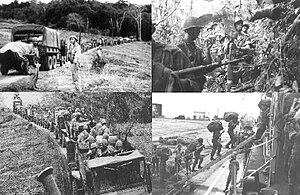Portugal Colonial Wars
| Portuguese Colonial War Guerra Colonial Portuguesa |
|||||||||
|---|---|---|---|---|---|---|---|---|---|
| Part of the Decolonisation of Africa and the Cold War | |||||||||
 |
|||||||||
|
|||||||||
| Belligerents | |||||||||
|
Supported by:
|
|||||||||
| Commanders and leaders | |||||||||
Generally:
Angola:
Portuguese Guinea:
Mozambique:
|
Angola:
Portuguese Guinea:
Mozambique:
|
||||||||
| Strength | |||||||||
|
148,000 European Portuguese regular troops
|
38,000–43,000 guerrillas
|
||||||||
| Casualties and losses | |||||||||
|
|
||||||||
Civilian casualties:
|
|||||||||
Independence of Angola, Cape Verde, Guinea Bissau, Mozambique and São Tomé e Principe:
148,000 European Portuguese regular troops
38,000–43,000 guerrillas
The Portuguese Colonial War (Portuguese: Guerra Colonial Portuguesa), also known in Portugal as the Overseas War (Guerra do Ultramar) or in the former colonies as the War of Liberation (Guerra de Libertação), was fought between Portugal's military and the emerging nationalist movements in Portugal's African colonies between 1961 and 1974. The Portuguese regime was overthrown by a military coup in 1974, and the change in government brought the conflict to an end. The war was a decisive ideological struggle in Lusophone Africa, surrounding nations, and mainland Portugal.
The prevalent Portuguese and international historical approach considers the Portuguese Colonial War as a single conflict fought in three separate theaters of operations (Angola, Portuguese Guinea, and Mozambique). However, some other approaches consider the existence of three distinct conflicts, the Angolan War of Independence, the Guinea-Bissau War of Independence, and the Mozambican War of Independence. Occasionally, the brief conflict that led to the 1961 Indian Annexation of Goa is also included.
...
Wikipedia
